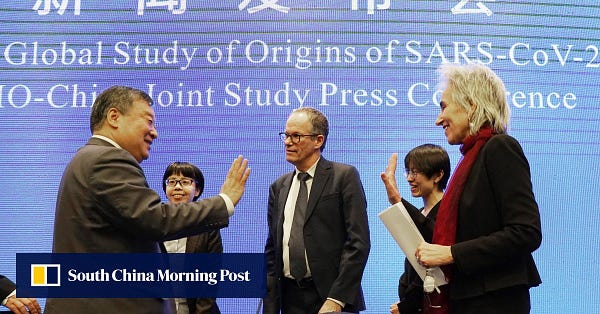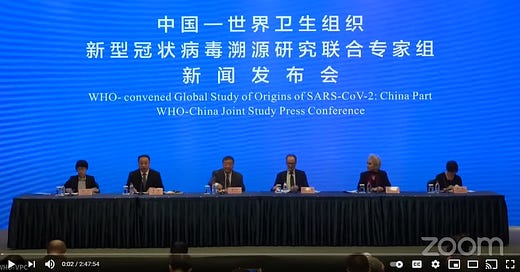The WHO Covid Origins Team has Placed the WHO in a Very Tough Spot
By waging an aggressive public relations campaign long before its work is completed, the WHO origins team is placing the WHO's credibility at risk
At a two-hour plus news conference in Wuhan yesterday, an expert committee convened by the World Health Organization to investigate the origins of COVID-19 reported its initial findings. Among its initial conclusions are several that will unavoidably and unnecessarily place the credibility of the entire WHO on the line.
A first conclusion reached by the expert team is that the hypothesis that COVID-19 may have escaped from a laboratory setting is so implausible that further exploration of the possibility should be halted. The committee chair, Peter Ben Embarek, explained that the possibility of a lab leak “is not in the hypotheses that we will suggest for future studies.”
According to committee member Peter Daszak, disease ecologist and president of the EcoHealth Alliance, a nonprofit with a history of conducting research into SARS-related coronaviruses and their effects on humans, the decision of the committee to downgrade the lab leak hypothesis was unanimous among its member. Daszak’s role on the team has been questioned due to his long-standing collaborative relationship with the Wuhan Institute of Virology and long-standing opposition to the lab leak hypothesis.
Through a large number of extensive media interviews, Daszak has established himself as the public voice of the WHO team. In one interview following yesterday’s news conference Daszak appeared to acknowledge the potential conflict of interest associated with his collaboration with WIV researchers, explaining that he initially recused himself from the WHO team’s discussions of the lab leak, and only spoke after all other team members. However, we are left to wonder what overwhelming evidence was presented to the committee.
The apparent dismissal of the lab leak theory has been interpreted as a public relations win for the Chinese government. Yanzhong Huang, a senior fellow for global health at the Council on Foreign Relations told The New York Times of the WHO team’s initial conclusions, “This is the most authoritative support that China has received in terms of its official narrative.”
The WHO went further, suggesting that the “most likely” hypothesis is that COVID-19 arrived in China from another country via the importation of frozen animal meat. In another interview, Daszak explained that there is “good evidence” for the “cold chain hypothesis.”
In yet another interview, with CNN, Daszak both promoted (and also contradictorily appeared to also play down) the “cold chain” hypothesis. He emphasized the central role that imported animals or animal products may have play at the (now closed) Wuhan market, which was the location of many early COVID-19 cases. Daszak’s comments to CNN are worth considering in full, because they provide some insight to the evidence (or lack thereof) that is behind the aggressive media campaign:
“What we see there when we visit that market is a place that sold a lot of frozen products, not just the typical things we would see at the supermarket, but also frozen animal products from animal farms in Southeast Asia and inside China. And there is a really striking piece of evidence that was mentioned today in the [WHO] press conference that in those products were included wildlife meat and carcasses from animals that we know are susceptible to coronaviruses and also that the supply chains come from places in China where we know that SARS-Coronavirus-2 related viruses are. In other words, a direct link from the potential bat origins of this virus, which most scientists believe is true, into Wuhan Market. Now scientists in China tested those carcasses and they were negative. So that’s good. But we don’t know what else was there. We don’t really know if there were live animals there, and there is no evidence of that, but we don’t know. And we don’t know how many of these animals were part of that frozen market or even the types of meat. So to many of us on the [WHO] team, it was a clear clue as to what may have happened. And it was one of the pathways that we thought was more likely than others, for sure.”
The CNN interviewer responded, appropriately, “I’m struggling to understand the specific evidence that you have to support this contention.”
Daszak’s reply was lengthy and confusing:
“Well the specific evidence comes from what the Chinese scientists have been doing. From really day one of the outbreak, around January 1st scientists from China CDC went into the market and started swabbing the market. They looked at sewage, they looked at stalls where they sold food, they looked at the stalls where the people were positive for coronavirus. They spent about a month in there swabbing, testing with over 900 samples tested, and really thorough, deep study, and most of the animal products had gone but there were some still there, and there were live animals in the market, we think mainly aquatic animals, but we don’t know, there is rumors of live mammals in that market. But what was really intriguing was this find of carcasses of animals, mammals, actually ferret-badgers, which are a type of animal which are widely eaten across Southeast Asia, which we know has the capacity to be infected by coronaviruses in the frozen products, which tested negative, but only a few. So that tells you that there is potentially more going on in that market early on. And this is a potential for a way that the virus could get in.
Daszak outline two other origin hypotheses, one being that the market was not actually the origin of the outbreak and the “cold chain” hypothesis, which here seems to downplay:
There are two other pathways that we looked at, one that could have been brought in by people from another part of Wuhan, and you heard that by the time of the early cases in December were known about, it looks to the epidemiologists on the team that this virus was already spreading pretty widely in the community and there’s evidence that some people were infected who weren’t associated with the market. So a person could have brought it in. And finally there’s this widely discussed hypothesis that the cold chain of frozen food from other places like abroad could have brought it in. Now that’s in my opinion less likely but possible so we kept it in there as a potential to do further work on. It’s fairly straightforward to go out and start testing those to see what the possibility is of that pathway is. But for my opinion and I’m very interested in the animal link to these pandemics there was a clear potential for an animal link, from animals we know are susceptible into that market.”
I am obvious not qualified to render judgments as to the likelihood of various COVID-19 origin hypotheses, but I am well qualified to render judgments of the validity of evidentiary claims in support of hypotheses. And in these interviews, and others I’ve seen, Daszak and other WHO Team members have provided very little evidence to support any of the initial conclusions that have been advanced by the investigation team.
It is both rare and risky for an expert advisory committee, on any topic, to engage in an aggressive media campaign to promote their findings long before their actual report is written. One reason it is rare is that early claims made in public may or may not ultimately be supported by the report. Public claims made by representatives of such committees are in effect a promise about the future. They are promising that the claims that they are now making, almost entirely without evidence or substantiation, will in the future be backed up by evidence.
That’s why it is good practice for members of expert advisory committees to stay mum until their work is done and their their findings are documented and shared. Early public statements (which can be contradictory among teams members) are a fast track to a delegitimized final product.
In addition, such early claims are risky for at least two reasons. First, public claims create ground that needs to be defended. A future departure from initial claims — no matter how well-justified by the evidence that is ultimately produced — can easily be seen (and spun) as delegitimizing of the committee’s work. So the origins committee is now effectively locked in to these conclusions, even as they continue their work.
A second risk is to the WHO itself. By empaneling a team without proper management of conflicts of interest and (apparently) without proper media training, the organization has now staked its credibility on defending the Chinese narrative for how the pandemic began. Because the WHO has been criticized for being overly deferential to China, any final report of this committee that does not support — overwhelmingly and undeniably — the team’s initial conclusions will likely lead to further debate over China’s influence on the WHO.
Going forward, the WHO finds itself in the position of having to defend its dismissal of the lab leak hypotheses and promotion of the cold chain hypothesis. Daszak has already previewed that the WHO team will shift its focus to beyond China’s borders, telling the BBC:
"We've done a lot of work in China and if you map that back it starts to point towards the border and we know that there is very little surveillance on the other side in the whole region of South East Asia. China is a very big place and South East Asia is a very big place. The supply chains to the Huanan seafood market were extensive, they were coming in from other countries, they were coming in from various parts of China, so to really trace that back it's going to take some work."
Further complicating the situation that the WHO now finds itself in, Daszak responded to reports that the U.S. government wishes to independently verify any findings of the WHO team, by impugning the motives of President Joe Biden and casting aspersions on the integrity of the U.S. intelligence community.


A more appropriate response would have been to welcome any and all independent verification of their work, based on the assertion that any independent look into COVID-19 origins will arrive at the same place — the truth. The optics of the WHO team’s most visible member actively defending the Chinses government while attacking that of the U.S. are just not good.
Observing the work of the WHO origins team, I’m reminded of an old joke. Some tourists who are lost ask an old timer for directions back to their hotel. The old timer responds, “Well, I wouldn’t start from here.”
The WHO expert advisory team finds itself in a very messy situation, almost entirely of its own making. It is not too late to correct course, but it is getting close.





It's disappointing that they seem to be basing things more on what it politically pleasing to China - lab no way, frozen food yay - rather than doing stuff like analysing blood and wastewater samples etc which is what a proper scientific study would look like I think.
Two things: That's a real tweet? Trust first and then verify? Sounds like what I'd call "silverback science".
Second "I am obvious not qualified to render judgments as to the likelihood of various COVID-19 origin hypotheses, but I am well qualified to render judgments of the validity of evidentiary claims in support of hypotheses." I think the idea that folks from other disciplines are capable/incapable of that judgment is worthy of much more thought and discussion- since we don't seem to have that discussion across disciplines much in parts of climate science. The difference that in more humble realms with more humble scientists is called... "the best answer we can give with the time and funding available" versus "the correct answer."